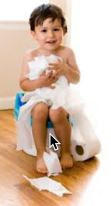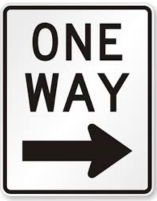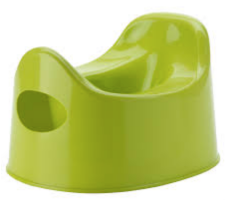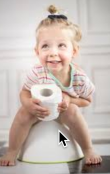 Children transition out of nappies and towards a potty or toilet at different times, in different ways and at difference paces according to their age, stage of development and family or parent preferences. Most girls will transition around 2 years old and boys around two years and three months, but this is not a guide, and could be different for different children. It takes time for children to develop control over their bowels and bladder. Adults can support children by being consistent, supportive and encouraging. This short guide will give you some tips and ideas about how to prepare your child, and work with the staff at Rainbow to help your child’s transition from nappies be a successful one.
Children transition out of nappies and towards a potty or toilet at different times, in different ways and at difference paces according to their age, stage of development and family or parent preferences. Most girls will transition around 2 years old and boys around two years and three months, but this is not a guide, and could be different for different children. It takes time for children to develop control over their bowels and bladder. Adults can support children by being consistent, supportive and encouraging. This short guide will give you some tips and ideas about how to prepare your child, and work with the staff at Rainbow to help your child’s transition from nappies be a successful one.
What we do at gan?
As children start to show signs of interest in using the potty or the toilet (we have small child sized toilets) – we sit them on the potty or toilet in between each nappy change to start getting used to the feel of it. There are other children around, so those new to the potty or toilet learn from their more experienced peers. When children succeed to urinate, or pass a bowel movement in the potty or toilet, we encourage and praise them.
What should you do at home?
Have lots of opportunities for ‘nappy free’ time, where your child can run around, and experience having no nappy. They need to feel and experience the sensation of urinating  and passing a bowel movements without a nappy before they will start to develop bladder or bowel control. Don’t expect children to actually use the potty in the beginning, this will take some time. Provide lots of opportunities for children to get used to sitting on the potty, especially when they don’t need to use the toilet, as this will remove any ‘pressure’, and just give them the opportunity to get used to the feeling of sitting on this funny little pot!
and passing a bowel movements without a nappy before they will start to develop bladder or bowel control. Don’t expect children to actually use the potty in the beginning, this will take some time. Provide lots of opportunities for children to get used to sitting on the potty, especially when they don’t need to use the toilet, as this will remove any ‘pressure’, and just give them the opportunity to get used to the feeling of sitting on this funny little pot!
Communication with gan staff
Its very important that you communicate what you’re doing at home so that we can mirror similar experiences at gan, and we can align our expectations at home and gan, so we are all on the same page!
There’s no turning back!
 Once you have made the decision to remove the nappy, and start to go out and spend time in underwear instead, it is very important that you communicate this clearly to your
Once you have made the decision to remove the nappy, and start to go out and spend time in underwear instead, it is very important that you communicate this clearly to your
child. After you have made this decision, it is very important that you don’t turn back or change your mind. Consistency is everything!
Take the potty with you
In the first month or so, it’s a great idea to carry the potty round with you when you are out of the house. Children will be most comfortable toileting on their own potty rather than in a  public toilet or other unfamiliar pot. Take lots and lots of spare knickers and pants with you whenever you leave the house. When children have accidents, remind them “Can you feel that you are wet? That’s because you have done a peepee in your pants.
public toilet or other unfamiliar pot. Take lots and lots of spare knickers and pants with you whenever you leave the house. When children have accidents, remind them “Can you feel that you are wet? That’s because you have done a peepee in your pants.
You can use the potty when you feel like you need to pee. Lets put some dry pants on you….”One method of toilet training, is to actually sit the child on the potty every 15 minutes, and encourage them to see if anything will come out, and praise them heavily when they do. This often results in less accidents.
Please don’t surprise us!
Transitioning from nappies to using the toilet or potty is something we should know about  well in advance at gan, and we should be working together. Please don’t just come in one day and announce that your child is out of nappies now. This rarely works, and results in lots of toileting accidents at gan. Let’s agree in advance when the right time to stop using nappies is.
well in advance at gan, and we should be working together. Please don’t just come in one day and announce that your child is out of nappies now. This rarely works, and results in lots of toileting accidents at gan. Let’s agree in advance when the right time to stop using nappies is.
What will happen at first…
When children are in the transitional period, which for some children can be a few weeks, and for others a few months, we leave the children without trousers, just underwear. This  is so that they can quickly remove clothing in order to use the toilet. It also means that we can much more quickly identify accidents.
is so that they can quickly remove clothing in order to use the toilet. It also means that we can much more quickly identify accidents.
Please bring up to 10 spare knickers or pants per day, and extra spare outer clothing. We will feedback to you each day regarding how your child’s toileting experiences were with us, and tell you about any accidents.
It is likely that children will have more toileting accidents whilst they are at gan, in comparison to when they are at home. This is mainly because there is a lot of stimulation and exciting things going on in the gan, and children often see going to the toilet as an inconvenience when they fist start having to do it!
Finally…
Remember to discuss and reinforce hygiene with your child. Model hand washing, remind children that we flush the toilet after we use it, talk your child through how you wipe and clean them up, so they can start to develop these skills too.
